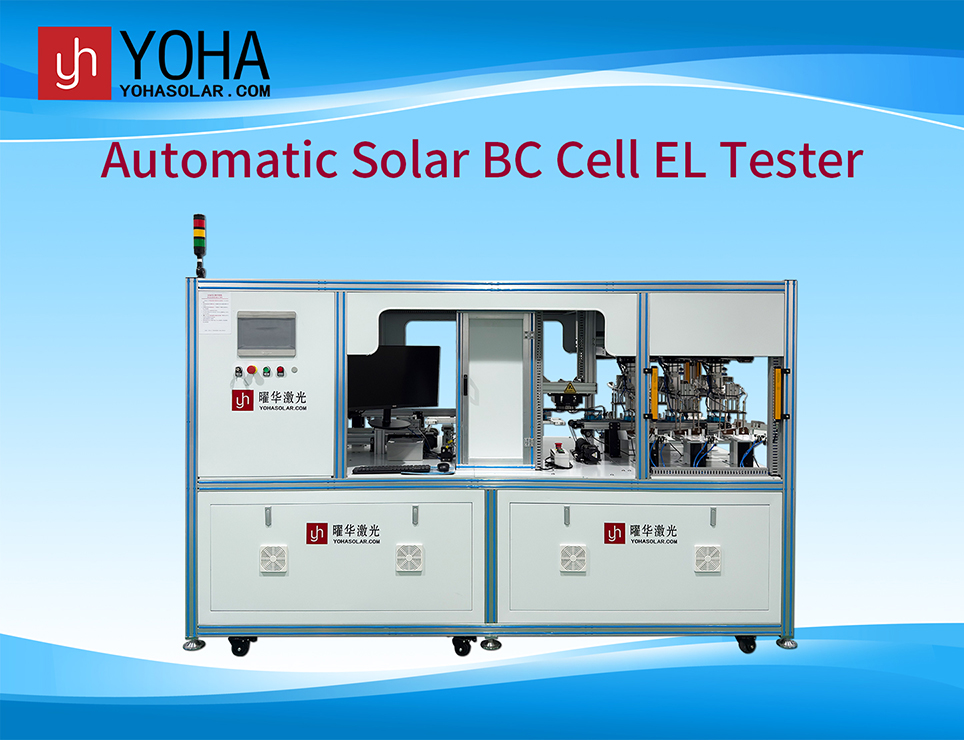Welcome to Wuhan Yoha Solar Technology Co., Ltd!
common problem
Site Map
Language:
 Chinese
Chinese
 English
English
Welcome to Wuhan Yoha Solar Technology Co., Ltd!
common problem
Site Map
Language:
 Chinese
Chinese
 English
English
With the rapid development of the photovoltaic industry, quality inspection has become a critical step in ensuring the efficiency and reliability of solar cell modules. As an advanced non-destructive testing equipment, the solar cell string EL tester is widely used in production lines to help manufacturers improve product quality and production capacity. So, what are the basic functions of a solar cell string EL tester? This article will provide a detailed analysis of the core functions of this equipment, offering valuable insights for industry professionals.
The solar cell string EL tester operates based on the principle of electroluminescence (EL). By applying an electric current to the cell string, it causes the cells to emit light, thereby revealing internal defects. This technology efficiently identifies issues that are difficult to detect with the naked eye, such as micro-cracks, fragments, or contamination. As photovoltaic technology advances toward higher efficiency and larger-scale production, the basic functions of the solar cell string EL tester have become a focal point in the industry. Below, we will explore these functions one by one.

First, the solar cell string EL tester offers high-precision defect detection, which is one of its core applications. The device captures infrared light emitted by the cell string when energized, generating high-contrast EL images. These images clearly display internal defects such as micro-cracks, broken grids, and black cores in the cells. Since the reliability of solar cell strings directly affects the lifespan of the entire module, the EL tester can detect these issues early, avoiding subsequent losses. Specifically, the defect detection function includes automatically identifying defect types, locating defect positions, and providing quantitative data such as defect area and distribution. This helps production personnel quickly adjust processes and improve yield rates. Therefore, when discussing the basic functions of a solar cell string EL tester, defect detection is undoubtedly the top priority.
Second, the solar cell string EL tester supports efficient image acquisition and processing. The equipment is typically equipped with high-resolution cameras and optical systems, enabling it to capture EL images of the entire cell string in a short time. Image processing algorithms then analyze the raw data, enhance image quality, and reduce noise interference. This function not only improves detection speed but also ensures result accuracy. For example, in some automated production lines, the solar cell string EL tester can capture images in real time, compare them with standard templates, and automatically mark abnormal areas. Such automated processing significantly reduces labor costs, aligning with the demands of modern smart manufacturing. When evaluating the basic functions of a solar cell string EL tester, the efficiency of image acquisition and processing is often a key consideration.
Third, data analysis and report generation are another critical function of the solar cell string EL tester. After testing, the device generates detailed data reports, including defect statistics, cell string performance ratings, and trend analysis. These data can be exported in various formats, such as PDF or Excel, facilitating traceability and decision-making for quality management personnel. Through long-term data accumulation, companies can also analyze common issues in the production process and optimize process parameters. What are the basic functions of a solar cell string EL tester? The data analysis function is not limited to immediate detection but also supports historical data comparison, helping predict equipment maintenance cycles or raw material quality changes. Such intelligent analysis enhances overall quality control.
Fourth, the solar cell string EL tester typically features automation integration capabilities, allowing it to seamlessly connect with production lines. In modern photovoltaic factories, testing equipment needs to collaborate with devices such as robotic arms and conveyor belts. The EL tester achieves automated control through standardized interfaces (e.g., PLC or industrial Ethernet), reducing manual intervention. This includes automatic detection triggering, result feedback, and sorting command issuance. Automation integration not only improves detection efficiency but also ensures the continuity of the production process. For users wondering about the basic functions of a solar cell string EL tester, this function demonstrates the equipment's adaptability in the Industry 4.0 environment.
Fifth, a user-friendly operating interface is also one of the basic functions of a solar cell string EL tester. The equipment is usually equipped with a touchscreen or software interface, supporting intuitive parameter settings, image browsing, and report viewing. Even non-professionals can quickly learn to operate it, reducing training costs. Additionally, some high-end devices offer remote monitoring capabilities, enabling multi-site data management through cloud platforms. When summarizing the basic functions of a solar cell string EL tester, operational convenience cannot be overlooked, as it directly affects the equipment's popularity and application effectiveness.
Sixth, the solar cell string EL tester may include calibration and maintenance assistance functions. To ensure long-term stability of test results, the equipment requires regular calibration. The EL tester often comes with a built-in calibration module, supporting automatic or semi-automatic calibration to reduce downtime. Meanwhile, maintenance reminder functions help users plan maintenance schedules and extend the equipment's lifespan. Although this function is auxiliary, it is crucial for ensuring detection accuracy. When discussing the basic functions of a solar cell string EL tester, calibration and maintenance reflect the equipment's reliability design.
Finally, the basic functions of a solar cell string EL tester also include performance evaluation and optimization support. By analyzing the EL images of cell strings, the device can indirectly evaluate parameters such as conversion efficiency and series resistance. This provides valuable data for R&D departments to improve cell design or material selection. For example, the tester may identify efficiency losses caused by specific processes, thereby driving technological iterations. Thus, the solar cell string EL tester is not only a quality inspection tool but also a catalyst for technological upgrades.
In summary, the basic functions of a solar cell string EL tester encompass defect detection, image processing, data analysis, automation integration, user interface, calibration and maintenance, and performance evaluation. These functions collectively ensure the high-quality production of photovoltaic modules, meeting the industry's demand for efficient and intelligent testing. As technology advances, the basic functions of a solar cell string EL tester may further expand, such as incorporating artificial intelligence algorithms for more accurate predictive maintenance. For photovoltaic companies, a deep understanding of these functions will help optimize production processes and enhance market competitiveness. If you have further questions about the basic functions of a solar cell string EL tester, it is recommended to refer to professional materials or consult industry experts for the latest information.
keywords:TOP
18086473422
MESSAGE
